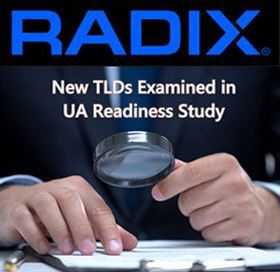|
ICANN
is preparing to open the door to another round of new
gTLDs next year and a lot of people are
getting ready to make a run at acquiring and
administering a new top level domain of their own
(as we told you last month, there is even a new
book out explaining how to do it). Of
course, the process of launching new TLDs now has
a fairly long history after hundreds hit the
Internet over a decade ago. A good thing about
that is you can better prepare by studying how
previous new TLDs have performed since joining
legacy TLDs like .com, .net and .org on the web.
On that front, Radix,
one of the most successful operators of multiple
new TLDs from the first wave, just released a
study detailing how new gTLDs have fared by one
critical measure - Universal
Acceptance (UA). |

Image
from Bigstock
|
|
If you
want to sell new TLD domain registrations your
customers are going to want know that any any
enterprise they build on your new extension will
work as flawlessly as possible on the web. To find
out how the original new TLDs have done in meeting
that objective Radix evaluated how well e-commerce platforms support
domain names and email addresses that use new
top-level domains.
Driven by Radix’s commitment to improving user
experience across modern domain formats, the study
highlights the progress made, as well as the gaps
that remain. The findings support the broader
industry goal championed by the Universal
Acceptance Steering Group (UASG), which
aims to make the internet more inclusive and
accessible for all users. Radix evaluated
145 e-commerce platforms across 16
categories, including website builders, payment
providers, email services, and social media
management tools. The study tested whether email
addresses using new short TLDs (three characters
or fewer, for example, .fun and .uno), new long TLDs
(four characters or more, for example, .online and
.website), and Internationalized
Domain Names were accepted during standard
sign-up processes.
Key
Findings:
1)
14 out of 16 e-commerce platform categories
showed full acceptance of new short and new
long TLDs during user sign-ups.
2)
New short and new long TLDs achieved a combined
acceptance rate of 98.6% across all platforms
tested, indicating strong overall support for these
domain types in sign-up workflows.
3)
IDN-based
email addresses had an average acceptance rate
of 39.31% across all platforms tested,
indicating significantly lower support compared to
new short and new long TLDs.
|
Neha Nair, Trust & Safety Director at Radix,
noted, “This study was driven by our intent to stay ahead of issues that users may face when adopting new top-level
domains. As a registry operator, we see it as
our responsibility to share insights that can support the advancement of Universal Acceptance. The findings highlight both the progress made and the work that still remains to ensure consistent acceptance of newer domain formats. We hope this research contributes to the collective industry effort to build a more inclusive and accessible internet.”
Radix has shared the findings of this study with
platform owners and developers to encourage
improvements in email validation and
domain acceptance. By identifying these
gaps, Radix aims to help technical teams
align their platforms with Universal
Acceptance best practices. |

Neha Nair |
(Posted
June 6, 2025)
*****
|





